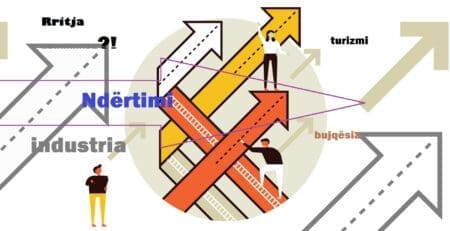A fast look of Albanian economy and ‘oligarchs’
Albanian economical – financial ‘lions’, or Albanian oligarchs, are the embodiment of Albania’s transition to capitalism. In contemporary Albania, the term denotes a large-scale businessman who controls resources sufficiently vast to influence national politics. The first mention of oligarchs was probably made before and maybe it’s said that these people exerted significant influence on Albania’s state policy.
Are these oligarchs likely to be agents of economic and political change, or opponents of such change?
On the one hand, oligarchs are the only feasible counterweight to the predatory and corrupt Albanian bureaucracy; and they are a unique constituency that is both willing and able to lobby for the development of market institutions. They are also the only Albanian owners who can afford to invest and restructure Albanian businesses in a very hostile business climate.
On the other hand, the oligarchs have weakened Albania’s economy directly, by stripping assets from Albanian firms and sending money abroad, and indirectly, by discrediting the ideas of private property and corporation among the public at large. They have also weakened Albania’s democratic institutions, by capturing state agencies and civil institutions.
The debate about the role of the oligarchs will probably go on for decades. Several quantitative assessments, however, can already be made.
How many oligarchs are there in Albania?
What assets do they control, and how well do they manage them? Should the oligarchs’ empires be broken?
How high is the concentration of wealth in Albania compared to other countries?
The structure of ownership is in main Albanian industrial sectors, including natural resources, manufacturing, construction, and market services.
In the resource, industry, financial and telecommunication services, 15 sectors were selected, representing 70% of total sales.
The true ownership, who is it?
Indeed, ownership of Albanian economy is highly concentrated: 60 large business groups control about 69% of economic output, more than all other private owners put together. The assets of the largest private owners are concentrated in the natural resources industries and services.
Many of the differences observed between oligarch-controlled firms and other firms are determined by industry specifics. For example, oligarchs’ control over large enterprises can be explained by the fact that they operate in industries where the average enterprise is large. Similarly, oligarchs’ firms are on average more productive, but if we compare productivity levels of firms controlled by oligarchs and by other private owners within the same industries, the difference in productivity turns out to be insignificant.
Still if we look at productivity growth, the oligarchs’ enterprises have fared well, controlling for size, industry and location. In 2016, the oligarchs outperformed other private Albanian owners by 6.5% in terms of total factor productivity growth. Their firms are inferior only to foreign-owned firms (which beat other Albanian firms by 19%). It should be noted that fast productivity growth is associated with greater output growth rather than a dramatic decrease in employment.
Do oligarchs hold excessive market power in the sectors that they control?
The sectors controlled by oligarchs are those that are highly concentrated. However, these are also the tradable goods sectors that are most subject to global competition. Except for good sales, construction and raw material manufacturing, all of other sectors sell to regional markets.
The financial sector, however, is a classic example of interest-group politics. The financial groups are internationally competitive and the sector has always relied on expansionism, which has increased along with growing oligarchic control over the economy.
Thus, except for the industry sector, there seems to be little reason for concern over the oligarchs’ excessive market power.
Some oligarchs are important global players in their industries (especially in oil, cigarettes and energy), but none is a dominant market leader. Albania therefore does not need antitrust policies aimed at breaking up oligarchs’ holdings.
Albanian oligarchs in an international perspective
Cross-country comparisons of wealth concentration are usually based on the share of market capitalization controlled by a certain number of families (e.g. ten). By this measure, ownership concentration in modern Albania is higher than in any other country for which data are available.
However, in historical perspective Albania does not seem to be unique. Quite a few countries have gone through a period of high ownership concentration, but they have eventually moved on.
These countries have achieved high levels of economic growth, although the high concentration of ownership has in all cases slowed down the development of an effective democratic system.
The most serious problem created by Albania’s oligarchic capitalism is that privatization has not led to secure property rights. Albanian voters still do not fully recognize the legitimacy of privatization.
This has created a conflict between the core free market values (private property rights), on the one hand, and crucial democratic values (majority rule), on the other. However, the problem of the illegitimacy of concentrated ownership cannot be resolved by a simple redistribution of wealth. Historical experience suggests that the size and composition of conglomerates depends on the institutional environment and market conditions.
Hence, if oligarchs’ empires are broken up and sold piece by piece, they are likely to reemerge as unified groups, albeit controlled by new owners.
Nationalization will not work, either. The assets currently controlled by oligarchs can and should be run by private owners; there are no externalities or public good arguments involved, and the inefficiency of Albania’s state-owned companies is notorious.
It is not surprising that in our dataset privately owned firms consistently outperform public companies, controlling for industry, location, and size. The only way out for Albania lies in further financial development, the enforcement of competition policies, openness, lower entry barriers, and a more effective legal system.
Shares in turnover and employment controlled by each category of owners are shown below:
| Owner category | Employment | Turnover |
| Largest private owners (60 groups) | 35% | 45% |
| Other private domestic | 25% | 23% |
| Foreign | 7% | 12% |
| Local governments | 4% | 7% |
| Central government | 17% | 12% |
| Other | 12% | 1% |
Who owns Albania?
You know!




Leave a Reply
You must be logged in to post a comment.